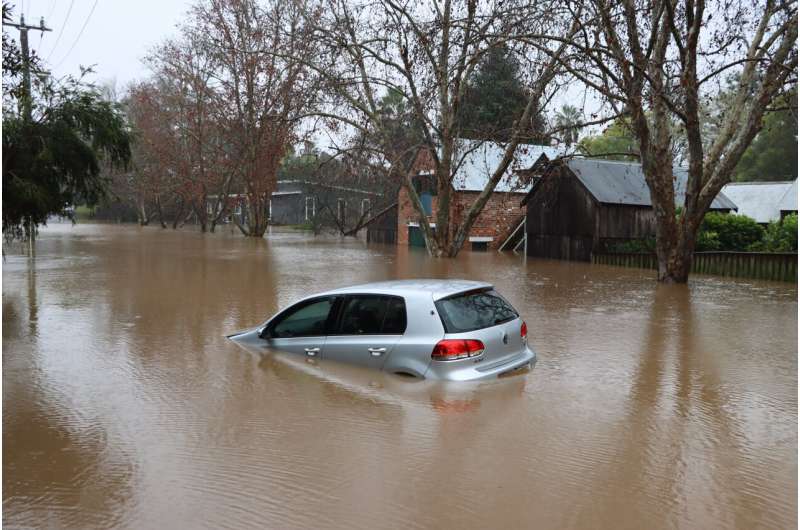[ad_1]

Credit: Unsplash/CC0 public domain
The cleanup of Auckland’s devastating floods last week has only just begun, but insurance companies will need to start thinking about what the record weather event will mean for future cover.
In 24 hours, 249mm of rain fell in the Auckland region, well above the previous record of 161.8mm. Around 5,000 homes were damaged in 25 suburbswith over 100 dwellings declared uninhabitable the day after the storm.
In the short term, insurers have had to provide assistance based on individual policies – for some this will include housing assistance while homes are uninhabitable, as well as an assessment of final payments.
But in the longer term, insurers will now have to consider whether parts of Auckland will become significantly more expensive to insure. In the worst case scenarioweekend flooding could mean some sections of the city are becoming too expensive to be insured by the general public Insurance businesses.
A small army of assessors and builders
In general, New Zealanders are adequately covered by home insurance, with banks requiring basic home insurance as requirement for mortgages. However, the total extent of cover will depend on individual policies.
The first hurdle to payment will be getting the properties appraised in a timely manner. Insurance companies will have to send experts to account for the damage, estimated at “several million” by Prime Minister Chris Hipkins.
But timely assessment and reconstruction will run into two larger problems: Permanent skills shortage in construction and a shortage of materials.
Insurers will have to find enough qualified people, builders for example, to assess the damage. Many badly damaged properties will also have to be rebuilt from scratch, putting further pressure on the construction sector.
Predicting the damage of climate change
Although insurers focus first on assessing damaged properties, a bigger problem looms: climate change.
The first national climate change risk assessment, published in 2020, identified 675,500 New Zealanders as living in areas already prone to flooding. Another 72,065 would live in danger if some of the most dramatic effects of sea level rise occurred.
It is clear that we have suburbs and even towns where, in hindsight, houses should not have been built.
Insurers are also faced with problems setting premiums. Currently, insurance premiums are based on the cost and livelihood of past events. Climate change makes this information questionable and the future cost of insuring weather speculative change.
Internationally, insurance companies are now investing millions in research to better understand the risk of adverse weather events related to climate change.
If climate change means these events become more frequent, New Zealanders with homes in high-risk areas could see substantial spikes in premiums. Increasingly, the trend is to calculate premiums house by house, with neighboring properties ending up paying different premiums depending on the risk of flooding and earthquakes.
Insurance companies might also decide that certain homes or areas are simply not worth the risk – like IAG did for some properties in Wellington due to earthquake risk, forcing owners to seek insurance from special underwriters. This will inevitably lead to a significant additional cost.
The impact of climate change on premiums is not hypothetical. Last year, Tower becomes New Zealand’s largest insurer to introduce a new pricing model based on the risk of flooding of individual houses. In a significant change from traditional practice, the risk assessment was also made public. Other insurers should follow.
Targeting LIM reports
Insurance companies do not just publish their own ratings. Insurers also support government efforts to require councils to include material risks in the Land Information Memorandum (LIM) reports of individual properties.
Last year the Local Government Official Information Bill Amending Bill was presented to parliament, setting out requirements for councils to make LIM reports clear and concise. The bill, which is currently open to the public, requires councils to provide clearer information about hazards such as floods and earthquakes.
Some risks, such as a house at the top or bottom of a cliff, or along the coast, are obvious to potential buyers. But including less obvious threats, like inadequate local drainage, in the LIM report could help people reduce their long-term risk when buying a home.
These initiatives go against shorter term interest of some owners, who believe that including potential, but not certain, risks in an MFR report will significantly reduce the sale value of their properties.
New Zealand insurers are not alone in having to change the way they calculate premiums and how they manage risk. Worldwide, insurance companies discuss the long-term impact of climate change on their business. The recent floods in Auckland show that this problem is not a matter of potential risk, but rather a tangible reality.
Provided by
The conversation
This article is republished from The conversation under Creative Commons license. Read it original article.![]()
Quote: Climate change is already putting pressure on insurance companies – Auckland floods could be a turning point (2023, January 31) Retrieved January 31, 2023 from https://phys.org/news/2023-01- climate-companiesauckland.html
This document is subject to copyright. Except for fair use for purposes of private study or research, no part may be reproduced without written permission. The content is provided for information only.
[ad_2]
news.google.com